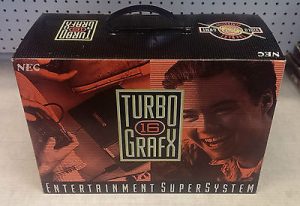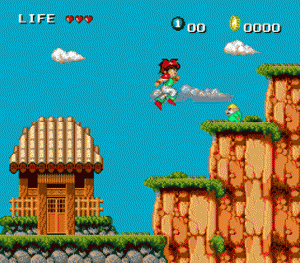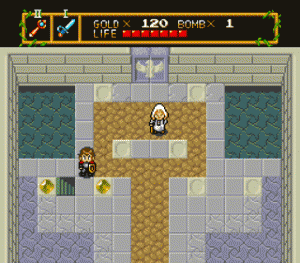As a child of the ‘80s, I grew up happily with our family NES, before the ‘90s threw me onto the 16-bit battlefield! Suddenly, 8-bit graphics were outdated, and it was time to choose sides in the new console war! While the Sega Genesis had been out for a couple years already, it only caught my interest when Sonic The Hedgehog blew up in 1991, revolutionizing the platformer genre with beautiful graphics, speed, and physics-play with the environment. The first two Sonic titles were everywhere, including demo stands in toy stores, TV commercials, magazines, and my friends’ houses who managed to persuade their parents to buy them a Genesis! For a generation that had grown up with 8-bit Mario, the new Sonic series seemed like a phenomenon.
 I found the first two Sonic titles far more exciting and better-looking than Super Mario World, so I never really considered the SNES for myself, in a world that emphasized choosing just one console! Sonic was definitely what I was excited for, so I wanted to join the dark side of Sega! I saved money from holidays and my birthday (in January), so that in early 1993, I had the full price needed for a Genesis. It was in the heat of battle against the SNES, with both consoles competitively dropping in price, and with Sega always keeping their console about $20 less expensive. I believe it was down to $119, plus tax.
I found the first two Sonic titles far more exciting and better-looking than Super Mario World, so I never really considered the SNES for myself, in a world that emphasized choosing just one console! Sonic was definitely what I was excited for, so I wanted to join the dark side of Sega! I saved money from holidays and my birthday (in January), so that in early 1993, I had the full price needed for a Genesis. It was in the heat of battle against the SNES, with both consoles competitively dropping in price, and with Sega always keeping their console about $20 less expensive. I believe it was down to $119, plus tax.
When I finally visited Electronics Boutique to buy myself a Genesis, I didn’t expect it to be a complicated process! But the store reminded me that there was one more “16-bit” system I had always seen in magazines, and which I had always been curious about: the TurboGrafx-16, which was cheaper than the Genesis! Boxes of the console were sitting in piles at the back of the store!
Information was so much more limited in the years before the Internet took off, and while magazines had always made me curious about the TG-16, it had always remained very mysterious! I never knew a single person who owned one. The console seemed like an interesting daydream, more than it seemed like something that really existed.
I couldn’t help marveling at the piles of discount TurboGrafx systems! Selling for maybe $40 less than the Genesis, they were so cheap for 16-bit graphics and action! The store was empty and the sales guy was a cool dude who didn’t mind that I asked him a million questions about it. Today, it’s not considered a 16-bit console anymore, but at the time, everyone thought it was, as it quietly competed against the Genesis and SNES in the early days of that generation!
I had to ask the sales guy if its graphics were “just as good” as the two big consoles, the Genesis and SNES? Since all three were considered 16-bit, it seemed to imply they were all on the same level. On the other hand, the TurboGrafx was relatively unknown, and it was clearly not selling well, with all these boxes gathering dust! Was there something wrong with it? Why was it so cheap and so unpopular? If the TurboGrafx was really just as good as the others, wouldn’t its lower price mean that it was automatically the best choice, out of all three?!
He explained to me honestly that the TurboGrafx was dying at the moment, and it would soon receive no more new titles or support! Was there any chance that it might stay alive? (No.) Okay, but it already has a huge awesome library, right? He explained that its US library was supposed to be pretty good, but it was relatively small, and he wasn’t very familiar with it; however, he generously pointed out that I could simply buy a TurboGrafx, try it out, and then if I wasn’t happy with it, I could return it within the store policy window of two weeks. Sold!
Not only was it cheaper, but it came with two pack-in titles, while the SNES and Genesis usually just came with one. So, the TurboGrafx seemed that it might be twice the value, for a smaller price! Bonk was absent from this package, despite being the best-known mascot of the console. Instead, the pack-in was a different mascot platformer I had never heard of: Keith Courage in Alpha Zones, which was decent, but seemed lacking. I wondered why Keith walks so damn slow, but at least the underworld balances it out with fast action, and a grinding metal soundtrack!
The second pack-in title was random, which was a fun gimmick, but which also implied that NEC was just giving away their piles of unsold games! I got a Zelda clone, Neutopia, which I liked a lot. Both titles are colorful and Neutopia has a beautiful soundtrack, especially the theme for the healing places, and I remember the animated water impressing me as a beautiful effect (compared to the environments I had seen on the NES).
Despite enjoying these two solid titles, I could tell that this console was definitely not on-par with the Genesis! Keith Courage and Neutopia both have a simplistic art style that doesn’t hold a candle to the Sonic series! Remembering that sales guy’s words, in two weeks I had my family drive back to the mall, with my TurboGrafx repackaged, and ready to be returned! Its value would go toward finally buying a Genesis, and I still had the remaining cash needed. This would be my second attempt at buying one, and I was extremely doubtful of getting distracted by a different console this time!
The store refunded me for the TurboGrafx, but before I could buy a Genesis, something else jumped out at me: A portable console whose box showed it playing 16-bit Sonic The Hedgehog! It cost the same exact price as the Genesis, so I decided that a portable Genesis would be even better!
Buying a large quantity of AA batteries, I fired it up in the car ride home, and I knew right away that it had been false advertising. This thing didn’t play Genesis games at all! It was a Game Gear, whose box just happened to show Genesis Sonic, falsely displayed on its screen!
It was obvious from the moment of powering it on: Game Gear Sonic has a title screen with a black background, instead of flying past waterfalls! But I didn’t feel disappointed to realize it was a different console altogether. I figured that the limited hardware must make sense for a portable, and I expected that Sonic must still be awesome. And I was happy to try it for two weeks, knowing I could return it, and use its exact refund value for a real Genesis!
I loved the Game Gear those two weeks, and I appreciated its back-light as soon as we drove home in the fading twilight. I still love that first Sonic title, and I remember making good use of its portability a couple times, as I brought it to a friend’s house, and also played Game Gear in the dark, when I slept over my beloved Grandma’s house. But in two weeks, I felt ready to graduate to the “real” Sonic titles, on a real Genesis! This would be my third attempt at buying one!
This time, it worked. I exchanged the Game Gear for a nice new Genesis, at the same exact price, and the rest is history! I must have caught the very best bundle package, and I didn’t even know about it, before buying it that day! Sonic 2 had already been out for a while, so the Model 1 Genesis was now coming with both Sonic 1 and Sonic 2! The first was included in the box, and a postcard would be mailed away to get Sonic 2 for free, in the mail. It gave me time to first appreciate the first title, and it let the suspense build up before the sequel arrived!
 If I had known about that package deal all along, then I might have never considered the TurboGrafx or Game Gear, as possible alternatives! But I’m glad that I got to briefly own both, using the same money shuffled around for three different consoles! Incredibly, after all that suspense, the Genesis did truly deliver the graphics and gameplay I had been hoping for. I later made one more big purchase when I bought Street Fighter II: Special Champion Edition from a magazine, before it was released in stores! At $75 plus tax, it’s still the most I’ve ever spent on a single game, even to this day! Those three cartridges (Street Fighter II plus the first two Sonics) mostly defined the 16-bit era for me personally. My collection was small but I owned a few gems that were among the absolute best of the generation, and which were better than most of the library that was out of my reach!
If I had known about that package deal all along, then I might have never considered the TurboGrafx or Game Gear, as possible alternatives! But I’m glad that I got to briefly own both, using the same money shuffled around for three different consoles! Incredibly, after all that suspense, the Genesis did truly deliver the graphics and gameplay I had been hoping for. I later made one more big purchase when I bought Street Fighter II: Special Champion Edition from a magazine, before it was released in stores! At $75 plus tax, it’s still the most I’ve ever spent on a single game, even to this day! Those three cartridges (Street Fighter II plus the first two Sonics) mostly defined the 16-bit era for me personally. My collection was small but I owned a few gems that were among the absolute best of the generation, and which were better than most of the library that was out of my reach!
In later years, retro-collecting for the Genesis has become a relatively cheap hobby, with hundreds of quality titles to collect for the Genesis, Sega CD, and 32x! Obscure games can be bought inexpensively in the form of repro’s, such as Chess, an unofficial release that was originally limited to Russia in the late ‘90s. With excellent artificial intelligence, Chess belongs as a repro in everyone’s Genesis collection! The world of hacks continues to create new versions of old classics each year, especially for Sonic and Streets of Rage, plus we keep seeing a few all-new homebrew releases, like Pier Solar! There is the true sense that we can never finish seeing everything that’s available for the Genesis, as the blast-processing keeps getting harnessed in creative new ways!
In the ‘90s console war, I’m glad that I chose the dark forces of Sega, and I’ve never looked back, with the Genesis still showcasing exciting new games to this day, in 2016! Welcome to the Next Level!



Recent Comments